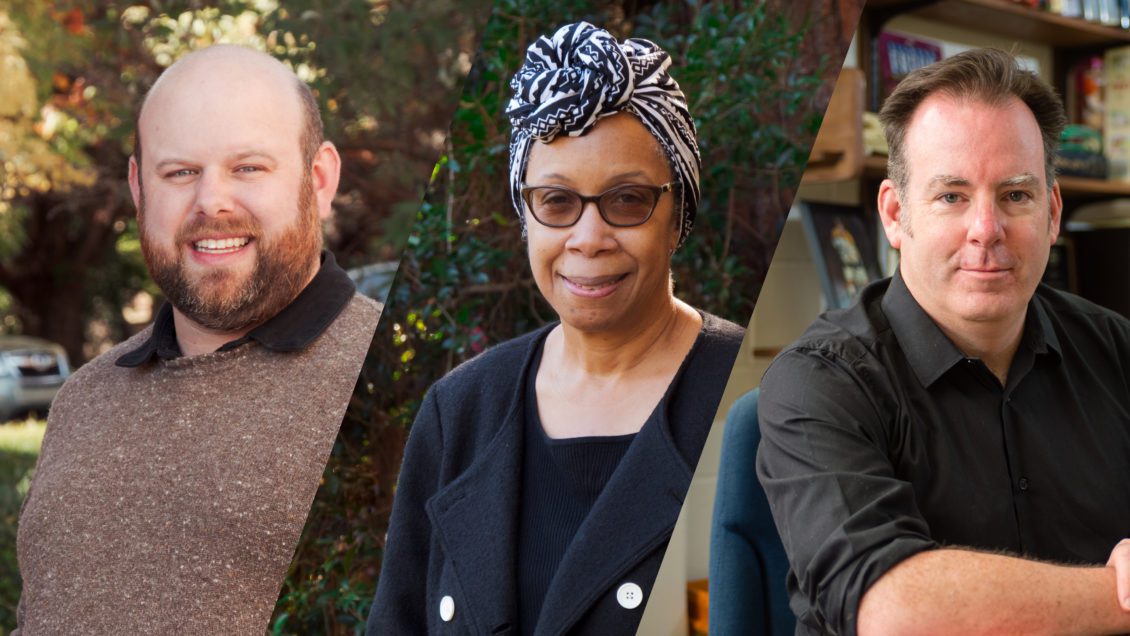Over the millennia, the extended campus of Clemson University has been inhabited by prehistoric Native Americans, Cherokee and Creek nations, settlers from the Ulster Plantation of Ireland, Revolutionary War troops, enslaved and free Africans and African Americans, and even Civilian Conservation Corps work sites.
Now, an interdisciplinary partnership coordinated by Clemson University Humanities Hub founding director and English professor Lee Morrissey has been awarded a $199,967 American Rescue Plan grant from the National Endowment for the Humanities, dedicated to “Exploring America’s Stories in the Clemson Landscape.”
During the winter of 2020, Calhoun Lemon Professor of English Rhondda Thomas initiated an inquiry that led a team of University researchers and staff, with the support of the Board of Trustees’ Legacy Council, to utilize ground penetrating radar to confirm the presence of 667 unmarked graves in the on-campus Woodland Cemetery. As part of ongoing research about the lives of enslaved and free African Americans who labored on Clemson’s land, the discovery of the unmarked graves also revealed how much of the land’s history can be lost to time.
By studying Clemson’s journey, we can gain insights into the challenges, failures, and successes of similar transitions in America and around the world, which can help us to be more engaged global citizens.”
Professor Rhondda Thomas, Department of English
“Clemson’s story doesn’t just start in the 1800’s. Clemson’s story starts 10,000 years ago,” observed David Markus, assistant professor of archaeology in the Department of Sociology, Anthropology and Criminal Justice, who was part of the team who uncovered the sites. “We know there are at least 250 largely undocumented historic and prehistoric sites just in Clemson’s experimental forest alone, but what we haven’t done is comprehensively surveyed what we have from an archeological standpoint.”
With the recent discoveries in mind, and the need for continued, coordinated archaeological work ongoing, a team including Markus, Morrissey, Thomas and Will Hiott, director of Clemson’s Historic Properties, applied for funding that will help with “Exploring America’s Stories in the Clemson Landscape.”
The funding will support postdoctoral archaeological researchers in the Department of Sociology, Archaeology, and Criminal Justice, and the expansion of archeological work on more than 18,400 acres owned by the University to document and discover the history of the many groups who have lived on the land over the course of Clemson’s history.
It will also support an Archaeology Field School on Clemson University Historic Properties, previously funded by Historic Properties admissions which declined due to pandemic closures.
With dedicated funding for a current post-doctoral researcher, La’Neice Littleton, the grant will also support continued research and initiatives for the “Call My Name” project, which under Thomas’ leadership has documented the story of African American life and labor in the Clemson area through a book, articles, tours, courses, museum collaborations and more.
“Slavery and its legacies were enacted on this land as the University slowly but reluctantly transitioned from a segregated to a desegregated school and more recently through its quest to become a more diverse and inclusive community,” Thomas said. “By studying Clemson’s journey, we can gain insights into the challenges, failures, and successes of similar transitions in America and around the world, which can help us to be more engaged global citizens.”
The grant is designed to enable partnerships for discovering, documenting and preserving Clemson’s history, connecting partners across the University including: the College of Architecture, Arts and Humanities, the College of Behavioral, Social and Health Sciences, the Clemson University Historian, Campus University Facilities and Clemson University Historic Properties.
English Professor Lee Morrissey, who put the grant together during the last months of his time directing the Humanities Hub he founded, notes “It’s gratifying that we’ve been able over the past five years to establish a track-record of NEH grants,” Morrissey said. “It shows that the Humanities at Clemson are successfully competing nationally.”
Markus explained that many of the same characteristics that make Clemson an attractive destination for students today make it ripe for archeological research. “Clemson is situated on a landscape that has been occupied for thousands of years,” he said. “It’s near waterways, it has good arable land, it’s not too hot, it’s not too cold. It’s a perfect location for where people are going to live.”
For Markus, the challenge begins with accurately mapping historical sites so that they won’t be lost to environmental changes or damaged by construction.
“If we don’t know what we have, we don’t know how to protect it,” he noted.
Once researchers have a clearer picture of what people left on the land, they can begin to piece together the stories of the lives they lived.
“The grant enables us to expand our research by incorporating more Native American history into our work as well as to hire researchers who will document African Americans in Clemson history full-time,” Thomas said. “We expect to recover more names of people of color who have made contributions to Clemson history as we seek to tell the University’s complete story.”
Get in touch and we will connect you with the author or another expert.
Or email us at news@clemson.edu

